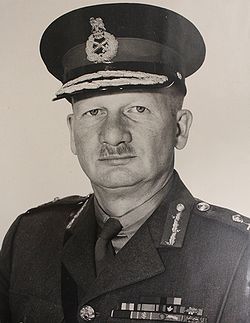Megill, William Jemmett
| William Jemmett Megill | |
|---|---|
| 26 June 1907 – 12 September 1993 | |
 | |
| Place of birth | Ottawa, Ontairo |
| Place of burial | Cataraqui Cemetery, Kingston |
| Allegiance | Canada |
| Service/branch | Canadian Army |
| Years of service | 1923 - 1959 |
| Rank | Major-General |
| Awards | DSO, CD |
Early Life
The eldest child of William Henry Thomas Megill and Juliana Margaret Jemmett, he was born in Ottawa in 1907. He had three younger brothers (Francis, Henry and Hugh) and a younger sister (Harriet) who died as an infant. He received his early education at Connaught School and Lisgar Collegiate.[1]
Service
In 1923 at the age of 16, he joined the Royal Canadian Corps of Signals as a Boy Soldier and rapidly acquired his technologist's qualifications. He was sent to Mayo, Yukon Territory, in 1924 to operate a post in the Northwest Territories and Yukon Radio System and, in 1928 he began studies at Queen's University, graduating in 1932 with a Bachelor's Degree in Applied Science as an Electrical Engineer.
As a junior officer, he served in Camp Borden as well as District Signal Officer in Toronto and Montreal. , and attended Staff College in Quetta, India (now Pakistan) in 1939, graduating after Canada had declared war upon Germany, and returning via the Pacific Ocean.
He proceeded overseas in 1941 as GSO II (Operations) with HQ 3rd Canadian Infantry Division. In October 1941 he was posted as GSO I (S.D) at CMHQ with the rank of Lieutenant-Colonel but returned to 3rd Division as GSO I in August 1942. In May 1943 he joined the staff of HQ 1 Canadian Corps as ADAG AG Branch with the rank of Acting Colonel and in June of 1943 was promoted Brigadier and made BGS HQ 1 Canadian Corps. In October 1943 he voluntarily reverted to the rank of Lieutenant-Colonel to take command of the Algonquin Regiment.
He was again promoted to Brigadier in February 1944, this time to command the 5th Canadian Infantry Brigade, comprising the Calgary Highlanders, the Royal Highland Regiment (Black Watch), and Le Regiment de Maisonneuve. His brigade landed in Normandy with the 2nd Canadian Division in July 1944 and saw continuous action from Caen in France through the Scheldt Estuary and Walcheren Island/South Beveland in Belgium to Nijmegan in Holland and had secured a crossing on the Rhine River in Holland when the war ended in May 1945. He was awarded the Distinguished Service Order in 1945 and the Order of Leopold by the Belgian Government after the war. He remained in Germany after the war to command the 2/9th Brigade of the Canadian Army Occupation Force.
Returning to Canada in 1946 he was appointed Deputy Chief of the General Staff. In 1948 he was selected to attend the Imperial Defence College in London, returning to Canada in December 1949. He became Commander B.C. Area in Vancouver in 1950, and commanded the 25th Canadian Infantry Brigade Replacement Group for Korea in Wainwright Alberta in 1952. In 1954 he was promoted Major-General and became the first Senior Military Advisor to the Canadian Delegation to the International Supervisory and Control Commission in Indochina based in Hanoi, North Vietnam. Returning to Canada in 1955, he become the General Officer Commanding Prairie Command based in Winnipeg. Major-General Megill retired from the Canadian Army in 1959 after 35 years of continuous service.
Personal Life
He married Doris Mary Kent 12 October 1936 in Kingston Ontario. Together they had twins, William Kent and Edith Margaret born 26 November 1940.
Upon retirement, he was appointed Executive Secretary and Director of Publications for the Royal Canadian Geographical Society, as well as becoming the Editor of the Canadian Geographical Journal. He retired from the Society in 1974 and relocated to Kingston Ontario. He was a lifelong member of the Association of Professional Engineers of Ontario, and and active lay member of the Anglican Church of Canada. He died 12 September 1993, predeceased in 1991 by his wife of 55 years, and was buried in Cataraqui Cemetery, Kingston.
Related Pages
- No related pages at this time
Related Items
References
- ↑ Research folder, Military Communications and Electronics Museum



